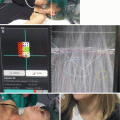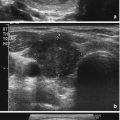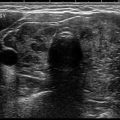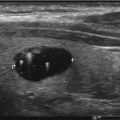Study
Study design
Number of subjects
% Response treatment group
% Response in placebo group
Significance
Gharib et al. (1987)
Prospective randomized double blind
53
14
20
NS
Reverter et al. (1992)
Prospective randomized controlled
40
20
15
NS
Papini et al. (1993)
Prospective placebo controlled
101
20
6
NS
LaRosa et al. (1995)
Prospective no placebo
45
39
–
S
Zelmanovitz et al. (1998)
Placebo controlled
45
29
8
NS
Larijani et al. (1999)
Prospective placebo controlled
62
19
13
NS
TSH suppression, especially with levels <0.1 mIU/L, can lead to many significant adverse events, including secondary osteoporosis and increased fracture risk from increased mobilization of bone mineral and increased cortical osteoclastic resorption [28–32]. Atrial fibrillation risk can increase by up to 20% [33, 34] with increased risk of cardiomyopathy and heart failure [35–37, 32]. Exercise intolerance with dyspnea and peripheral edema may also occur [38]. Increased morbidity and mortality, from TSH over-suppression, have been described [39, 40] along with decrements in health status, mood, and decision-making [41–43]. Practitioners should be aware of these risk factors when considering therapeutic strategies and goals of therapy when treating benign thyroid nodules.
While the recent literature is against the use of LT4-suppressive therapy to shrink thyroid nodules, clinical practice seems to lag behind recommendations. To evaluate current practice, Bennedbaek et al., surveyed members of the European Thyroid Association (ETA), in 1999 [44], and the American Thyroid Association (ATA), in 2000 [45], asking how to manage a “42-year-old woman with a solitary 2 × 3 cm thyroid nodule and no clinical suspicion of malignancy.” While everyone agreed that FNA biopsy, to rule out malignancy, was the best initial step, 60% of respondents from the ETA and 53% of ATA advocated against TSH-suppressive therapy to shrink a benign solitary nodule. Of note, these studies were conducted more than 16 years ago, and we believe that current practice suggests even less enthusiasm for suppressive therapy. Accordingly, both recent guidelines by the ATA [46] and the American Association of Clinical Endocrinologists (AACE) /Associazione Medici Endocrinologi (AME) [47] recommend against TSH-suppressive therapy to reduce the volume of cytologically negative thyroid nodules.
Conclusion
While controversy continues and treatment should be individualized, we emphasize “first, do no harm.” In 1998, Gharib and Mazzaferri, considering risks and benefits of T4-suppressive therapy, stated that “nodule shrinkage for its own sake… is a surrogate outcome that may not be of clinical value to patient or physician” [16]. In a detailed review published in 2003, Hegedus remarked that “In our own country [Denmark], this [LT4] therapy has been abandoned” [48]. We believe this trend to be also true in many other countries. It is our opinion that the recognition of the lack of efficacy of TSH-suppressive therapy, combined with significant potential complications, has been one of the landmark achievements of the twentieth-century endocrine practice.
References
2.
Swain VAJ. History and iconography of endemic goitre and cretinism. Med Hist. 1985;29(2):226–7.CrossrefPubMedCentral
3.
Eustachi B. Tabulae anatomicae clarissimi viri Bartholomaei Eustachii quas e tenebris tandem vindicatas et Clementis papae 11. munificentia dono acceptas, praefatione, acnotis illustrauit Ioh. Maria Lancisius archiater pontificus. s.l. : sumptibus Laurentii, & Thomae Pagliarini bibliop. sub signo Palladis ex typographia Rochi Bernabò. 1728: 225.
4.
Ignjatović M. The thyroid gland in works of famous old anatomists and great artists. Langenbeck’s Arch Surg. 2010;395(7):973–85.Crossref
6.
7.
Boussingault JB. Recherches sur la cause qui produit le goître dans les Cordilieres de la Nouvelle-Grenade. Ann Chim Phys. 1833;48:41–69.
8.
Niazi AK, Kalra S, Irfan A, Islam A. Thyroidology over the ages. Indian J Endocrinol Metab. 2011;15(Supp 2):S121–6.CrossrefPubMedPubMedCentral
9.
Coindet JR. Nouvelles recherches sur le eflfets de l’iode, et sur les precautions a suivre dans le traitement du goitre par un nouveau remade. Ann Chim Phys. 1821;16:252–66.
10.
Hartsock CL. Iodized salt in the prevention of goiter: is it a safe measure for general use? JAMA. 1926;86(18):1334–8.Crossref
Stay updated, free articles. Join our Telegram channel

Full access? Get Clinical Tree







